| dc.contributor.author | Natali, Mattia | eng |
| dc.date.accessioned | 2014-09-29T09:30:35Z | |
| dc.date.available | 2014-09-29T09:30:35Z | |
| dc.date.issued | 2014-09-19 | eng |
| dc.identifier.isbn | 978-82-308-2837-3 | en_US |
| dc.identifier.uri | https://hdl.handle.net/1956/8570 | |
| dc.description.abstract | Throughout this dissertation, solutions for rapid digitalization of ideas will be defined. More precisely, the focus is on interactive scientific sketching and communication of geology, where the result is a digital illustrative 3D model. Results are achieved through a sketch-based modelling approach which gives the user a more natural and intuitive modelling process, hence leading to a quicker definition of a geological illustration. To be able to quickly externalize and communicate ones ideas as a digital 3D model, can be of importance. For instance, students may profit from explanations supported by interactive illustrations. Exchange of information and hypotheses between domain experts is also a targeted situation in our work. Furthermore, illustrative models are frequently employed in business, when decisional meetings take place for convincing the management that a project is worth to be funded. An advantage of digital models is that they can be saved and they are easy to distribute. In contrast to 2D images or paper sketches, one can interact with digital 3D models, and they can be transferred on portable devices for easy access (for instance during geological field studies). Another advantage, compared to standard geological illustrations, is that if a model has been created with internal structures, it can be arbitrarily cut and inspected. Different solutions for different aspects of subsurface geology are presented in this dissertation. To express folding and faulting processes, a first modelling approach based on cross-sectional sketches is introduced. User defined textures can be associated to each layer, and can then be deformed with sketch strokes, for communicating layer properties such as rock type and grain size. A following contribution includes a simple and compact representation to model and visualize 3D stratigraphic models. With this representation, erosion and deposition of fluvial systems are easy to specify and display. Ancient river channels and other geological features, which are present in the subsurface, can be accessed by means of a volumetric representation. Geological models are obtained and visualized by sequentially defining stratigraphic layers, where each layer represents a unique erosion or deposition event. Evolution of rivers and deltas is important for geologists when interpreting the stratigraphy of the subsurface, in particular because it changes the landscape morphology and because river deposits are potential hydrocarbon reservoirs. Time plays a fundamental role in geological processes. Animations are well suited for communicating temporal change and a contribution in this direction is also given. With the techniques developed in this thesis, it becomes possible to produce a range of geological scenarios. The focus is on enabling geologists to create their subsurface models by means of sketches, to quickly communicate concepts and ideas rather than detailed information. Although the proposed techniques are simple to use and require little design effort, complex models can be realized. | en_US |
| dc.language.iso | eng | eng |
| dc.publisher | The University of Bergen | en_US |
| dc.relation.haspart | Paper I: Mattia Natali, Ivan Viola and Daniel Patel. Rapid Visualization of Geological Concepts. In Proceedings of SIBGRAPI Conference on Graphics, Patterns and Images, 2012, pp. 150–157. Full text not available in BORA due to publisher restrictions. The article is available at: <a href="http://dx.doi.org/10.1109/SIBGRAPI.2012.29" target="blank">http://dx.doi.org/10.1109/SIBGRAPI.2012.29</a>. | en_US |
| dc.relation.haspart | Paper II: Mattia Natali, Tore Grane Klausen and Daniel Patel. Sketch-Based Modelling and Visualization of Geological Deposition. In Computers & Geosciences 67C, 2014, pp. 40–48. Full text not available in BORA due to publisher restrictions. The article is available at: <a href="http://dx.doi.org/10.1016/j.cageo.2014.02.010" target="blank">http://dx.doi.org/10.1016/j.cageo.2014.02.010</a>. | en_US |
| dc.relation.haspart | Paper III: Mattia Natali, Julius Parulek and Daniel Patel. Rapid Modelling of Interactive Geological Illustrations with Faults and Compaction. In proceedings of Spring Conference on Computer Graphics (SCCG), 2014. Full text not available in BORA due to publisher restrictions. The article is available at: <a href="http://dx.doi.org/10.1145/2643188.2643201" target="blank">http://dx.doi.org/10.1145/2643188.2643201</a>. | en_US |
| dc.title | Sketch-based Modelling and Conceptual Visualization of Geomorphological Processes for Interactive Scientific Communication | en_US |
| dc.type | Doctoral thesis | |
| dc.rights.holder | Copyright the author. All rights reserved | en_US |
